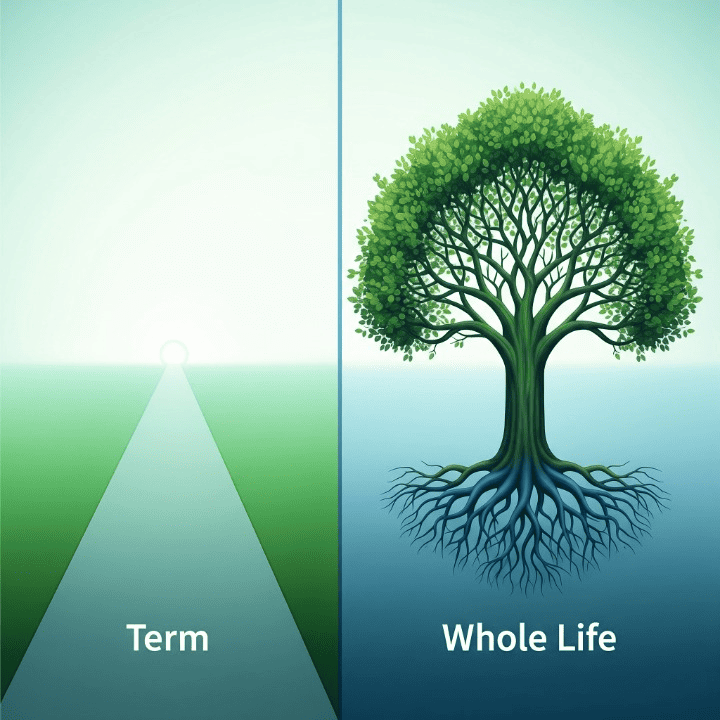
Introduction
Life insurance is a fundamental pillar of sound financial planning. It acts as a critical safety net and provides financial peace of mind. A good policy ensures your loved ones are protected in your absence. However, stepping into the world of life insurance can often feel overwhelming. You will face a dizzying array of policy types, riders, and industry jargon. Among the most significant decisions is the choice between term and whole life insurance. This is not just a minor detail. It is a foundational choice that will shape your financial strategy for years to come.
One path offers straightforward, affordable protection for a specific period. The other provides lifelong coverage with an added investment component. You must understand the fundamental differences, benefits, and drawbacks of term vs. whole life insurance. This understanding is essential for making an informed decision that aligns with your unique financial situation and long-term goals. This guide will demystify these two options. We provide a clear, head-to-head comparison to help you determine which path is the right one for you.
What is Term Life Insurance? The Power of Simplicity
Term life insurance is the simplest and most affordable type of life insurance. You can think of it as “renting” a death benefit. You pay a regular premium, typically monthly or annually, to an insurance company. In exchange, the company agrees to pay a tax-free lump sum to your beneficiaries. This payment, known as the death benefit, occurs if you pass away during a specified period, or “term.” Insurers typically offer terms of 10, 15, 20, or 30 years.
The primary purpose of term life insurance is income replacement. It covers temporary financial needs and responsibilities. For example, a young couple might have children and a 30-year mortgage. They could purchase a 30-year term policy. The death benefit would be large enough to pay off the mortgage, cover daily living expenses, and fund their children’s education if a parent were to die unexpectedly.
The defining characteristic of term life insurance is its purity. It has one job: to pay a death benefit. The policy has no savings account, no investment component, and no cash value. Once the term expires, your coverage ends. You stop making payments, and the insurance company’s obligation ends. You may have an option to renew the policy. However, the premium will be significantly higher because it will be based on your new, older age. Because of this simplicity, term life insurance offers the largest death benefit for the lowest premium. This makes it a highly efficient tool for protection during your peak earning years.
What is Whole Life Insurance? Protection for a Lifetime
Whole life insurance, as its name suggests, provides coverage for your entire life. The policy will remain in force as long as you continue to pay the fixed premiums. This type of insurance is a form of permanent life insurance. It is fundamentally different from term life because it combines a death benefit with a savings component, known as “cash value.”
A portion of your whole life premium payment goes toward the cost of insurance. The company allocates the remaining portion to the cash value account. This cash value is guaranteed to grow at a modest, fixed rate. Importantly, it accumulates on a tax-deferred basis, so you do not pay taxes on the growth as it occurs. Over time, this cash value can become a significant asset.
This accumulated cash value offers flexibility that term insurance does not. You can borrow against it, use it to pay your policy premiums, or even surrender the policy to receive the cash. Because whole life insurance provides lifelong coverage and includes this cash value, the premiums are significantly higher. They cost much more than a term policy with the same death benefit. Insurers often position it not just as protection, but as a long-term financial asset and an estate planning tool.
The Core Differences: A Head-to-Head Comparison
To truly understand which policy might be right for you, it helps to compare them directly. The distinction between term vs. whole life insurance becomes clear when you look at their features side-by-side.
Duration of Coverage
- Term Life: Provides coverage for a specific, predetermined period (e.g., 20 years). The policy expires with no payout if you outlive the term.
- Whole Life: Provides permanent coverage that lasts for your entire lifetime, as long as you pay the premiums. The policy guarantees an eventual death benefit payout.
Premium Costs
- Term Life: Premiums are significantly lower and are fixed for the term’s duration. This makes it highly affordable, especially for young, healthy individuals.
- Whole Life: Premiums are substantially higher, often five to fifteen times more expensive than a comparable term policy. These premiums must fund both the lifelong death benefit and the cash value account. However, these premiums are also fixed and will not increase with age.
The Cash Value Component
- Term Life: This policy has no cash value. It is pure insurance. You receive nothing back if you cancel the policy or outlive the term.
- Whole Life: A key feature is the tax-deferred cash value account that grows over time. This creates an asset you can access during your lifetime, adding utility beyond the death benefit.
Complexity and Flexibility
- Term Life: The policy is straightforward and easy to understand. Its purpose is singular: financial protection in case of premature death.
- Whole Life: This policy is more complex. It involves concepts like cash value accumulation, policy loans, and potential dividends. It offers more flexibility but requires a deeper understanding.
Who is Term Life Insurance Best For?
Term life insurance is often the ideal choice for the majority of people. It works especially well for those with specific financial obligations and a limited budget. It is most suitable for:
- Young Families and New Parents: It provides a large amount of coverage at an affordable price during the critical years when children are dependent.
- Homeowners with a Mortgage: You can structure a term policy to match the length of your mortgage. This ensures your family home is secure if a primary earner passes away.
- Individuals on a Budget: Term insurance offers the most cost-effective protection for those who need significant coverage but cannot afford high premiums.
- Business Owners Covering a Loan: A term policy can cover the duration of a significant business loan. It protects the business from defaulting if a key person dies.
The strategy often associated with term life is “buy term and invest the difference.” This involves purchasing an affordable term policy. You then invest the money saved on premiums into traditional retirement accounts like a 401(k) or an IRA.
Who is Whole Life Insurance Best For?
Whole life insurance serves a different set of financial goals. It is typically better suited for individuals in specific financial situations. It might be the right choice for:
- High-Net-Worth Individuals: This group may have already maxed out other tax-advantaged retirement accounts. The tax-deferred growth of the cash value can be an attractive feature for wealth accumulation and estate planning.
- Individuals with Lifelong Dependents: A permanent death benefit can ensure long-term care is funded for a child with special needs or another lifelong dependent.
- Business Succession Planning: Companies often use whole life policies to fund buy-sell agreements. The policy provides liquidity for surviving partners to buy out a deceased partner’s share of the business.
- Those Seeking to Leave a Legacy: The policy guarantees a death benefit. This makes it a useful tool to leave a specific, tax-free inheritance to children, grandchildren, or a charity.
Conclusion
The debate over term vs. whole life insurance does not have a single “winner.” The best choice is deeply personal. It depends entirely on your individual circumstances, financial goals, responsibilities, and budget. Term life insurance offers a simple, powerful, and cost-effective solution. It provides financial protection for your loved ones during a specific period of need. It prioritizes a large death benefit for a low premium, making it a practical choice for most families.
In contrast, whole life insurance provides a permanent solution. It combines a guaranteed death benefit with a disciplined, tax-advantaged savings vehicle. Its high cost makes it less accessible. However, it can be a valuable tool for complex estate planning and supplemental retirement savings for high-income earners. Ultimately, the decision requires a careful evaluation of what you want your life insurance to accomplish. Are you seeking pure protection, or are you looking for a lifelong financial instrument? By understanding the core functions of each policy, you can make a confident choice that builds a secure foundation for your family’s future.



